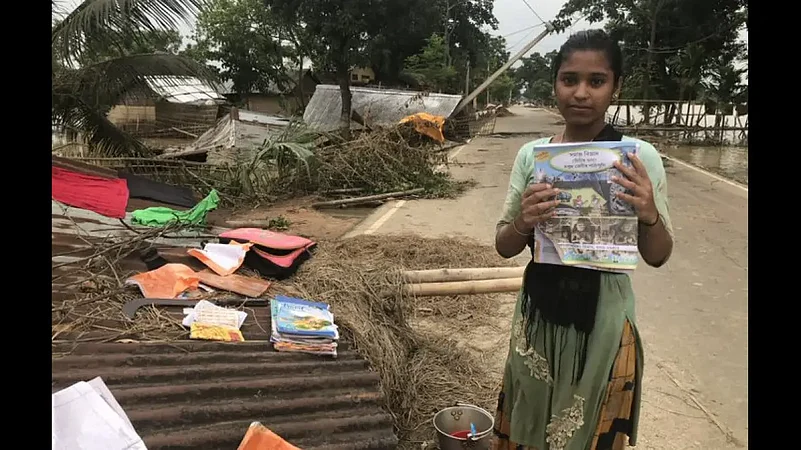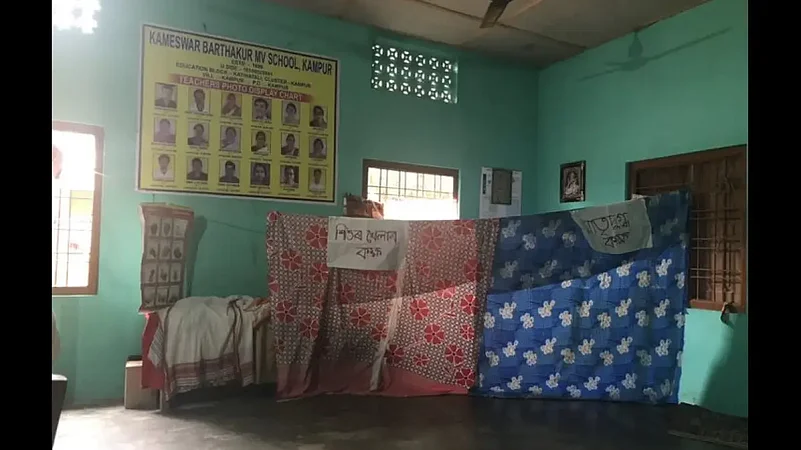On a gloomy Monday morning, 14-year-old Nazima Khatun was seen drying up her textbook upon a tin alongside the road in No. 1 Fakuli village in Kampur revenue circle of Nagaon district. The sun was hiding behind the clouds, and the rain had stopped for a while. The Class 7 student of Kameswar Borthakur MV school in Kampur, had arranged the books in a line. The cover of most of them had washed away. She carefully examined the glue that held the pages together, trying to salvage whatever was left of the books.
A few metres away, her mother Shahsida was washing a muddied study table. Khatun’s school has been turned into a relief camp since May after the pre-monsoon flood hit the district. For the first time, Nazima has witnessed such intense floods in the village. The flood water washed away her house, furniture, books and clothes. But for Shahsida, this is the third house that Kopili, the largest south bank tributary of The Brahmaputra has gulped down in the last 18 years. “The first house got washed away in 2004 during a massive flood. The government gave us a house, but it got destroyed in the 2021 flood. We built the last house this year with the tin roofs we salvaged from the previous house. We could not save much apart from a few tables and chairs and a few tins,” laments Shahsida.

At night, the mother and daughter take shelter in the school, about a kilometre away from where their house used to be. They share a room with more than 40 people. The school at present is housing 411 inmates. “We are provided with food and drinking water here,” Nazima informs.
Also Read | Assam Floods 2022: Diary From Silchar
Kopili is an interstate river that flows from Meghalaya to Central Assam before it meets The Brahmaputra. Every year, Kopili washes away lands, paddy fields, and houses displacing thousands of people. Flood water released from Kopili Hydro Power Station located in adjoining Dima Hasao district over the river, often inundated a huge part of Nagaon district.
The 2022 flood, however, has been the worst in the living memory of the people of Kampur. The river earlier would inundate the surroundings of Kampur town. Water could not enter inside business establishments, but this year it entered every home, shop and paddy field, forcing thousands to take refuge in raised structures like schools, embankments and pavements since May. “There are sluice gates around the area, and when water is released from the dam, we get a notification 24 hours prior to that. So, villagers get time to leave their houses with important belongings. However, this year is different. Along with water released by two dams, the incessant rainfall is causing additional furry,” informs Madhab Chandra Bhuyan, a local scribe.
As pre-monsoon showers began in mid-May, the flood came in two waves to Kampur. On May 13-14 the excess water released from Karbi Langpi Hydro Electric Power Project situated in Borpani River that flows through Nagaon district inundated several villages in the south of Kampur division. On May 17, water released from another dam, Kopili Hydro Power Station reached Kampur and flooded 107 revenue villages in the entire sub-division along with other parts of the district.
More people on the road than in relief camps
The roads in Kampur have become home for thousands of the flood-affected. The clusters of makeshift huts from colourful tarpaulin can easily be mistaken for a village funfair. However, every hut tells a heart-wrenching story of displacement, uncertainty and helplessness. Men, women, children, cows, goats, and dogs, are living under the same roof here. During the day, the cattle are tied outside the huts while the women cook inside the houses. Men were seen trying to catch fish from the water. Many are returning to their villages, hoping to find any valuables left behind. They make it a point to come back to the huts before it gets dark. No one dares to underestimate the destructive power of the river.
Sumeira Begum, 35, at present living on the Kampur-Karbi Anglong link road, recalls how she reached the spot. “Exactly one week ago in the evening, I started running towards the road with my three children and three cows from Balisara village and stopped only after I hit the road. I have been living here since then. My house is gone and so are my farmlands. I used to cultivate rice in 10 bighas of land by taking a loan from the Bandhan Bank. But all the fields are now destroyed, and I have no way to pay back the loans.”
In another hut of the same road, Yakub Ali, a seven-year-old boy was seen cuddling a calf while his father was sleeping a few feet away. The government relief camps have run out of space to hold such a large number of flood victims. A lot of these people go to the camp during the daytime to collect relief items in the form of rice, dal, oil, mosquito repellents, salt, biscuits, etc. At night they stay in these huts.
The Raha-Kampur and Kathiatoli-Kampur road is another location having witnessed the floods.
As of Monday, (July 4), flood water inundated 205 villages in five revenue circles of Nagaon—Kampur, Kaliabor, Raha, Samaguri and Rupahi. According to government data, 3,63,329 people in the district are highly affected by floods since pre-monsoon rains hit the state. About 11,260 people are currently residing in 36 relief camps in Nagaon district. It takes no effort to guess that a huge chunk of flood victims are living in makeshift temporary relief camps set up on their own.

Living in a relief camp
In Kampur, a building turns into a relief camp when flood victims start gathering in it. After that, the local headman starts procuring relief for the people. Naturally, the victims are way more in number than the space to accommodate them. Over 50-60 people are staying in one room at Kameswar Borthakur MV School, says Pradip Bora, a mid-day meal worker, who is also taking shelter in the house. No one knows the exact quantities of relief they are entitled to.
“We are getting relief, but it is not sufficient. We got one candle per room at night. For over 400 people, we get only four candles per day. One piece of Maxo (mosquito repellent) is allotted per room. Half a litre of mustard oil is being given to each person once in 10 days,” Bora laments. “Many in the relief camp complained of having fever, getting diarrhoea and skin disease. A classroom was converted into a temporary health camp with health workers. There were no separate toilets for men and women.”
According to Bhuyan, from common people to district administration officials, no one in the state was prepared to handle such massive destruction. “Now whenever we see people living on roads or other high areas, we intimate the ward commissioner or the village headman and make sure they provide relief. Still, there is no way to keep a record of who got what amount of relief in such a big crisis,” the scribe notes.
As of Monday (July 4), 325 relief camps in Assam are housing 1,55,271 people. In some parts, water is receding, but in many other parts, the levels are rising. Out of the 35 districts, 27 districts are still hit by flood leaving a population of 13,71,663 at risk. At the time of publishing this report online, a total of 180 people had lost their lives in the Assam floods.
















